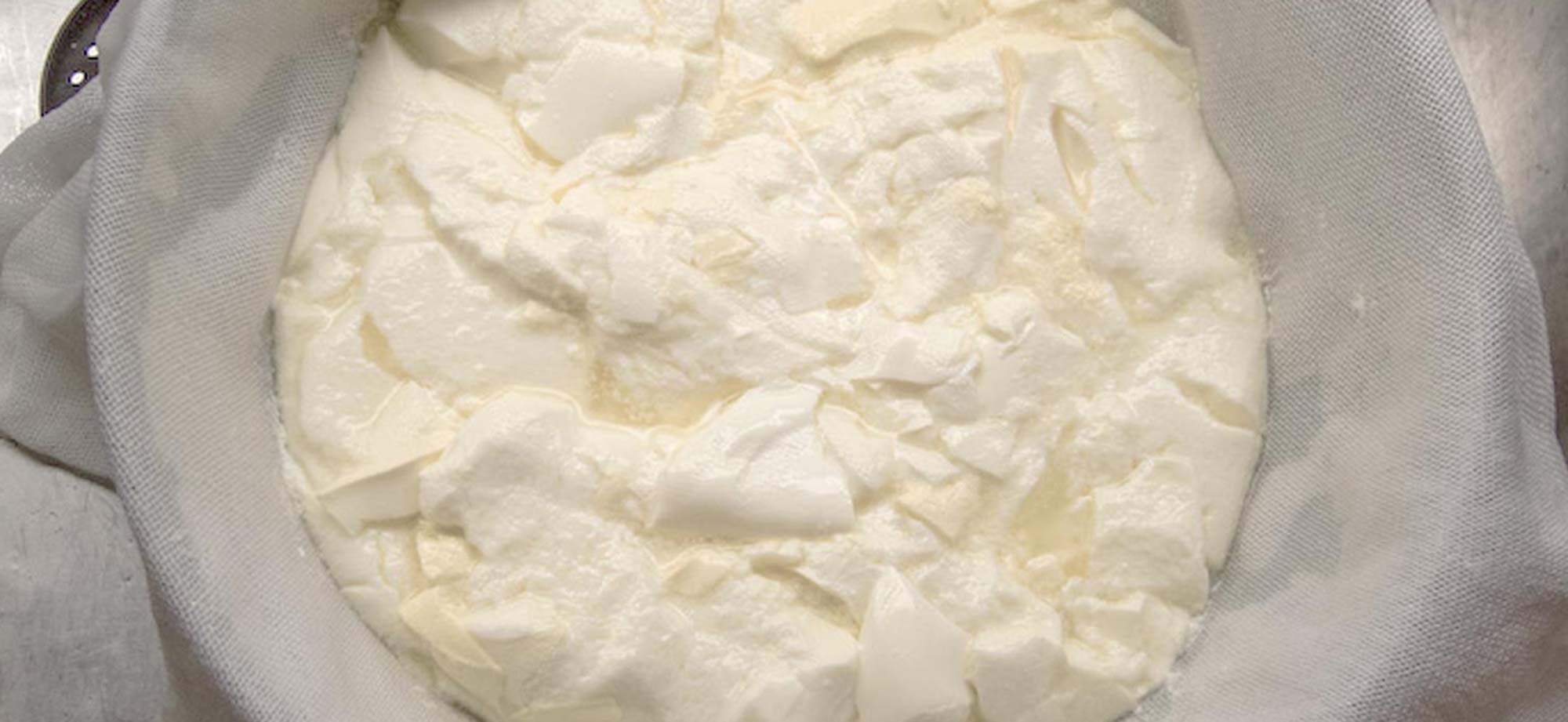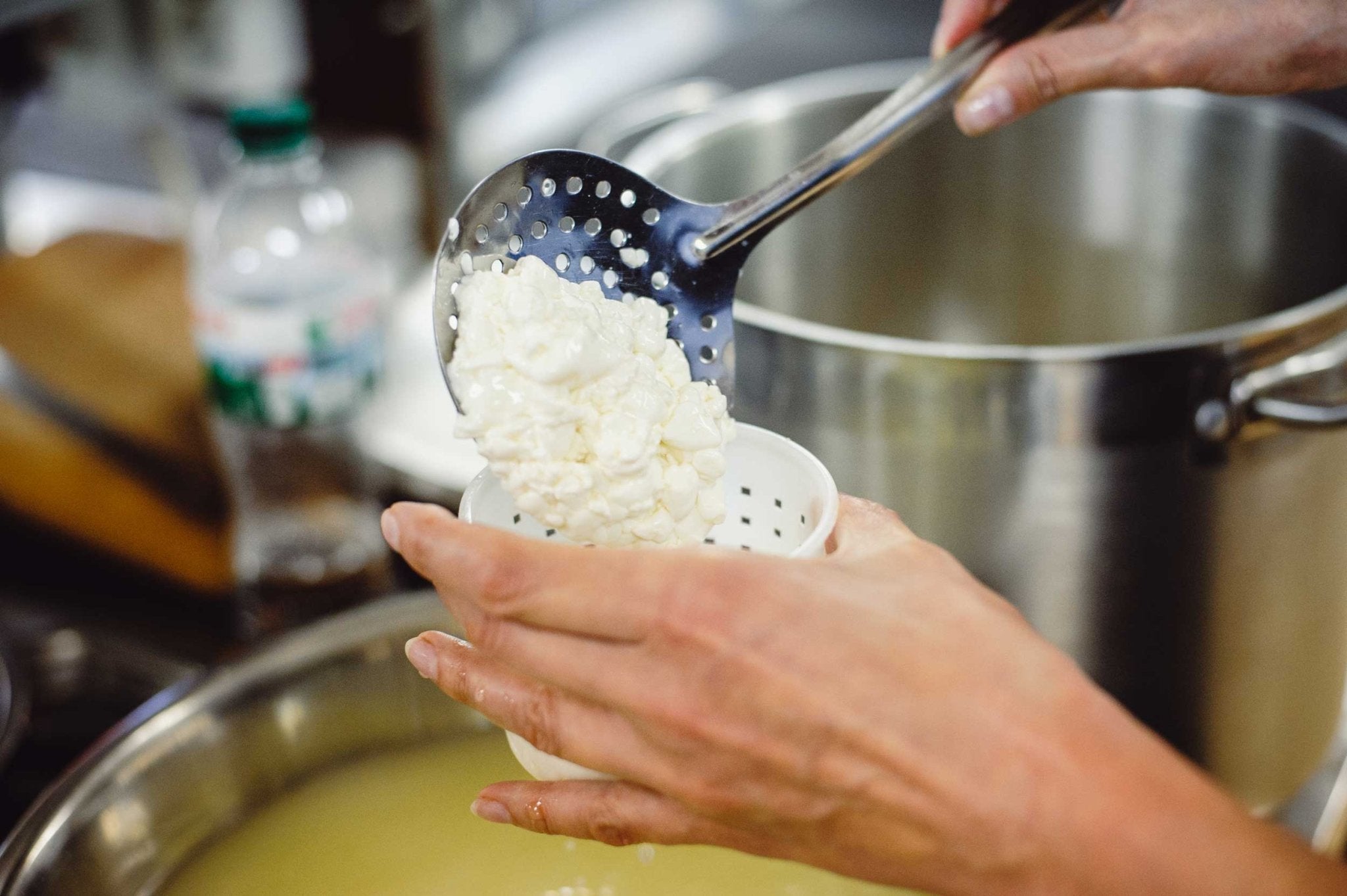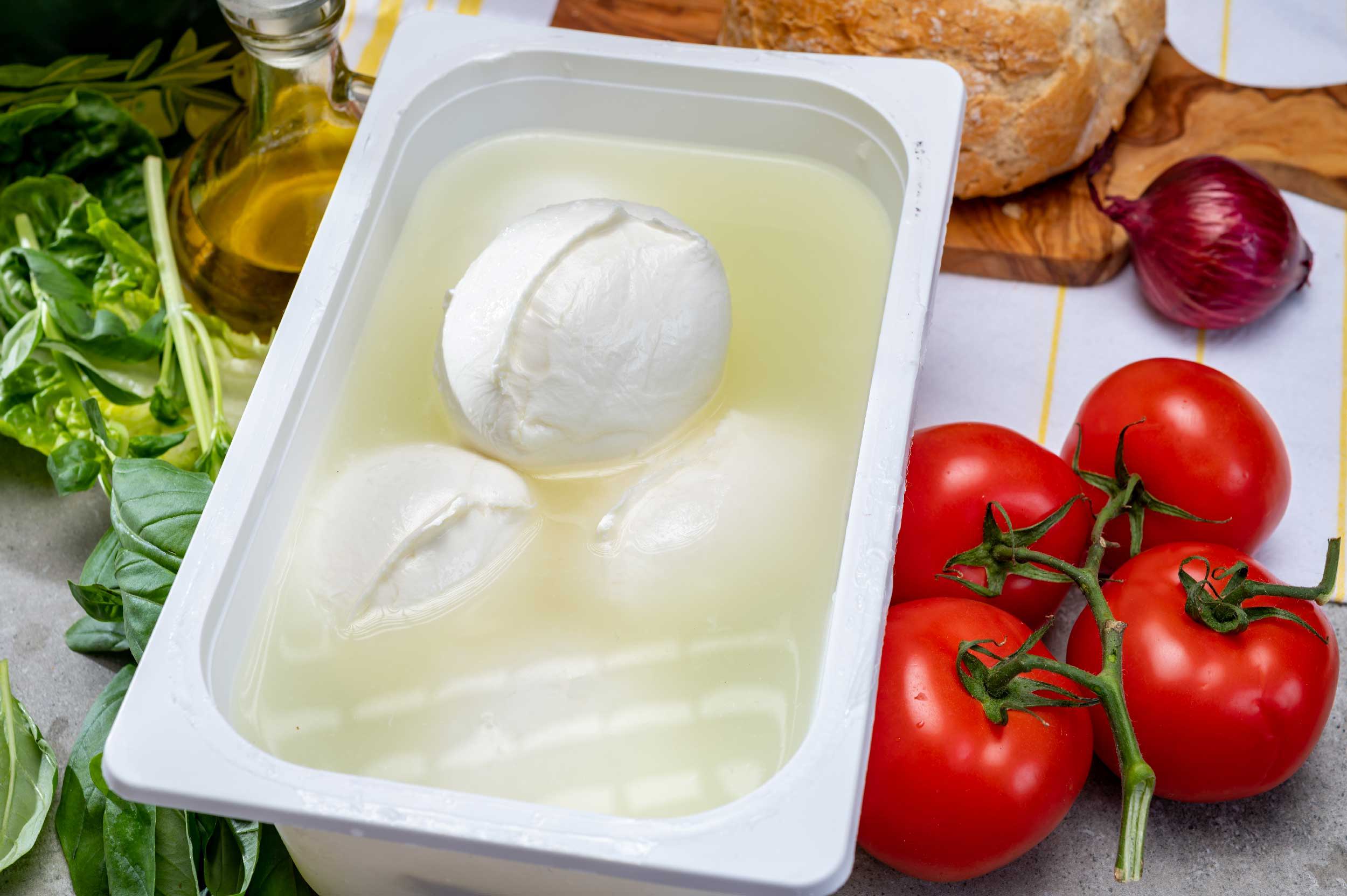
Cheddar Cheese Making Recipe
In addition to making your own Cheddar, you will learn why there are so many different varieties around the world and understand the history of this fantastic cheese.
Since we have tasted a lot of cheddar, and made many variations, we're able to give you our favorite recipe. It is the one we make ourselves, and the one Jim makes when you attend our 201 workshops.
-
Yield
3 Pounds
-
Aging Time
~3 Months
-
Skill Level
Intermediate
-
Author
Jim Wallace

Ingredients
Total price for selected items: Total price:
Instructions
A Recipe for Cheddar Cheese
I usually make this cheese with 6 gallons of raw milk because the larger size tends to ripen more effectively, while reducing the amount of moisture loss, due to a better ratio of mass to surface area. However, for the home cheese maker this volume of milk can be a lot to work with. So, I'm providing a 3 gallon recipe below using a good quality pasteurized milk.
The pictures with the guideline below will be for the larger cheese though and you should be able to increase the size to a 6 gallon batch by doubling the rennet and culture.
-

Heat & Acidify Milk
Begin by heating milk to 86F. A water bath using a pot in your sink will be the most stable way to do this. You can just add a bit of boiling water from your tea kettle to make sure the water bath remains at temperature. You can heat the milk right in the sink if you use a couple of changes of VERY hot water.
If you do this in a pot on the stove make sure you heat the milk slowly and stir it well as it heats.
As you can see in the picture here, I use a pot inside a bigger pot, and a burner under that to control my water bath temperature. Thermometers in both the milk and water bath will help in controlling temperatures
Once the milk is at 86F, the culture can be added. To prevent the powder from caking and sinking in clumps, sprinkle the powder over the surface of the milk and then allow about 2 minutes for the powder to re-hydrate before stirring it in.
The milk now needs to be kept at this target temperature for 90 minutes to allow the culture to begin working. It will be very slow initially but will soon kick into its more rapid rate of converting lactose to lactic acid.
-


Coagulate with Rennet
Once your milk and culture have ripened, add about 3/4 tsp of single strength liquid rennet.
The milk then needs to sit quiet for 45 minutes while the culture works and the rennet coagulates the curd. You should note that the milk begins to thicken at about 18 minutes (between 15-20 minutes is a range you should work to).
You should be able to see this change by pressing on the milk surface and noting a change in tension. However do not cut yet. The milk needs to sit quiet the full 45 minutes. It needs the rest of this time to firm up well and make a good curd before cutting.
The thermal mass of this milk should keep it warm during this period. Do not heat the milk during this time because it needs to sit undisturbed.
When the milk has turned into a solid curd that is ready to cut, you should be able to test and see a simple clean break as shown above.
-

Cut Curd & Release Whey
The next step will be to cut the curds to 1/2-3/4 inch pieces, depending on the moisture you want in the final cheese. The smaller the curds, the drier the cheese and the longer it will take to age. Make the cuts by first making vertical cuts in two directions at right angles with a long knife and then using a flat ladle cut horizontally. Try not to break the curds too small while doing this.
Once the curd have been cut as close to your target size as possible (they will shrink as they cook) allow them to rest for about 5 minutes, with no stirring, while the surface hardens a little.
The next step will be to begin a SLOW stir for about 10-15 minutes, the curds are still very fragile. Bring the curds back to 86F at this time if they have cooled. This is to firm the curds well enough to keep them intact during the scald, or cooking phase, that comes next.
-


Cook Curds
Now it is time to begin drying out the curds. This will be done by increasing the heat slowly to 102F. The heat needs to be increased slowly at about 3-5F every 5 minutes at the beginning. The total cooking time will be about 30 minutes
Then stir another 30-60 minutes, until the curd is firm. This may be extended if the curds are still soft.
The final curds should be cooked well through and should be examined to make sure that enough moisture has been removed. A broken curd should be firm throughout and the curds should have a moderate resistance when pressed between the fingers.
If the curds are not dry enough, they will carry moisture which contains Lactose forward into the pressing and aging stage. This will show up as leaking cheeses, as the acid continues to develop, and a very chalky and acid tasting cheese. A simple test that I always show in my workshop classes here is the 'Grip Test'. A small hand full of cheese is gathered and firmly pressed in the hand to consolidate the curds. Then with moderate pressure of the thumb, they should easily separate. If they tend to cling or stick together, stir for a little longer.
When the curds seem dry enough, they can be allowed to settle under the whey for a few minutes, then begin to remove whey down to within 1-2 inches above the curd mass.
-




Draining & Cheddaring
Draining
My process here involves the use of two pans, one with holes and the other without so that the initial curd transfer is with curds and enough whey to cover them. I line the pan with holes with draining cloth and place that pan inside the one without holes (see the pics). If you are using a colander for the draining simply place it in another larger pan
When the curds are transferred along with the residual whey to the draining pan, the curds should be fully covered with the whey. This arrangement allows for a thorough stirring to make sure any clumps are broken up and the curds allowed to float under the whey into their most compact form. This step will minimize any mechanical holes in the bed of curds. This step should take about 10 -15 minutes, then the cloth should be folded over and tightened around the curd and all of the whey can be drained.
Cheddaring
This is the beginning of the cheddaring phase, but the cheese at this point has not developed it's final acid. It will need to be kept warm (85-90F) and turned at 15-30 minute intervals for the next 2-3 hours. The actual amount of time depends on the draining and acid development. During this time, more whey will be draining, and the taste of the whey will change from just slightly sweet as in milk, to a very neutral and even slightly acid flavor but avoid developing too much acid. After about 1 hour cut the curd mass in half and stack the two halves with the drain cloth separating them.I also add a board on top of the draining curds with about 8 lbs of weight. This will emulate the larger slab mass of the larger producers.
During this time the curds will begin to change shape due to changes in the protein structure. It is quite related to what also happens in the mozzarella stretching phase. As the warm curd develops more acid during cheddaring, calcium (responsible for binding the proteins) is washed from the curd by the draining whey, leaving a weaker bond between proteins. You will notice that the curds at the beginning of the cheddaring process were much more cubic or round, but if you tear the slabs at the end they will be much more elongated and the slabs will have flattened out considerably. This is all a large part of what cheddar is about.
-


Milling & Salting Curds
At this point you will have the final curd ready for pressing BUT another unique aspect of the Cheddar is that the dryness and acid have both reached close to their desired level and should not be allowed to continue. If relying on brining or dry salting the surface of the cheese, the acid would continue to increase causing a very wet and acid cheese.
If at this point the curd is too wet, the residual lactose may still be enough to trigger a late fermentation and result in leaking cheese and a very acid and chalky final cheese.
If the curd is too dry, it will be difficult to consolidate and will take much longer to age.
The curd mass is broken into small pieces about thumb to walnut size, and salt is then added at the rate of 2% of cheese salt to the weight of the fresh curds.
If the curd weighs 3lbs (48 oz), 2% would be .96oz of salt.
About 0.5% will wash away as the salt pulls moisture from the curd, leaving about 1.5% in the finished cheese. To best keep the salt from hardening the curd surface, and thus limiting moisture expulsion, add salt in 3 stages over 15-20 minutes to allow each addition to pull whey and form its own brine.
-




Forming & Pressing
Once the curds have been salted, line the form with a sanitized press cloth and pack the curds firmly into the mold.
For pressing, we should begin very light and slowly increase the press weight to a moderate level:
- 1 hour at 20 lbs
- 1 hour at 20 lbs
- 4 hour at 40 lbs
- 24 hours at 50-75 lbs (depending on how well the consolidation is working)
The cheese should be removed from the press, unwrapped, turned, re-wrapped, and put back to the press at the above intervals, to ensure an even consolidation.
Pressing will not solve problems of a curd that is too moist. Only the free unbound moisture will be released during this phase.
The rate of whey running off is simply a matter of drops and not a stream of whey being released. This is a good rate of whey removal during pressing and will slow even more as the residual free moisture is released. The form should show tears of whey weeping from the form very slowly. When this stops you can increase the weight slightly. At each turn you will notice the cheese has formed a smoother surface and rests lower in the mold.
If at the end of the press cycle, the curd is not fully consolidated, return to the press for more time and add a bit more press weight.
If still not consolidated after pressing, the cheese curds were too dry. In the next batch, do less stirring, perhaps for less time. Also, cutting the curds larger will make a moister cheese.
-


Prepare for Aging
With the well pressed cheddar you have two choices, either waxed or cloth bound. Due to the dryness of the curd at molding, a natural rind will fail as the surface is likely to develop cracks as the curd boundaries dehydrate.
Waxing
The cheese can be dried for a few days and then waxed. All of our details for this are on our Waxing Page.
Pros:
- Easiest way to maintain moisture.
- Requires little attention during aging.
Cons:
- Limited movement through the waxed surface.
- Messy to apply and clean up.
- Requires constant attention to temperature, as wax can easily reach it's flash point if left unattended.
Wrapping in Cloth
This is the most traditional way of maintaining the surface of a cheddar. This is still the method used for the ""West Country"" Cheddars, as well as many of the newer cloth bound Cheddars in America.
Pros:
- This covering provides fine support for the surface, but allows moisture and gas to pass as needed.
- The final cheese tends to be much more complex in both aroma and flavor.
- Once the cloth is applied, the cheese is protected and a natural mold surface adds to the protection and complexity, and little aging attention is required.
- When fully ripe, the mold can be brushed away, the cloth removed and a perfectly clean rind is revealed.
Cons:
- It takes a bit longer to apply.
The cloth is applied with the help of lard as a binder. The cloth is soaked in lard, rung out and applied to the surface, and then pressed 24 hours to embed the cloth right into the surface.
I know that many will groan at the thought of lard, but there is no need to use that white block from the store. It is very easy to obtain a piece of back fat and heat it to render your own lard. It can be kept refrigerated for quite some time.
All of the details for applying the cloth binding are on our Bandaging Cheddar page.
-

Aging
The cheese is now ready to be placed into your aging space at 52-56F and 80-85% moisture.
The only maintenance required is to turn the cheese every week to keep the moisture even.
The waxed cheese should remain mold free if done correctly and fully sealed.
The bandaged cheese will develop a beautiful surface of grey-white-blue mold naturally over time. This acts as a filter for what comes and goes and can be left alone other than turning occasionally.
You may want to keep it separated from other cheeses that are developing selected natural rinds, but I age mine right with my other natural rind cheeses... no problem.
Age for 3-9 months (or longer) depending on cheese moisture. The drier the cheese, the longer it can be aged and the more complex it becomes.
Cheese Making Supplies
Related Products
Cheese Making Recipes
Recommended
Visit Our Blog
Learn About Cheese Making

Draining Soft Cheese: Tips for Creamy, Delicious Results
Draining is a crucial part of soft cheese making—it directly affects your cheese’s final texture, flavor, and shelf life. Whether you’re making tangy chèvre, rich cream cheese, or luscious fromage ...

Cheese Making pH Guide: How to Test and Control Acidity for Perfect Cheese
Understanding pH in Cheese Making: A Beginner-Friendly Guide When it comes to making cheese at home, understanding acidity and pH levels is essential for producing high-quality cheese with the perf...

How to Store and Age Cheese in Brine
Get the best results when storing and aging Feta, Mozzarella, or other Mediterranean style cheese in a brine at home, we'll show you how.






























